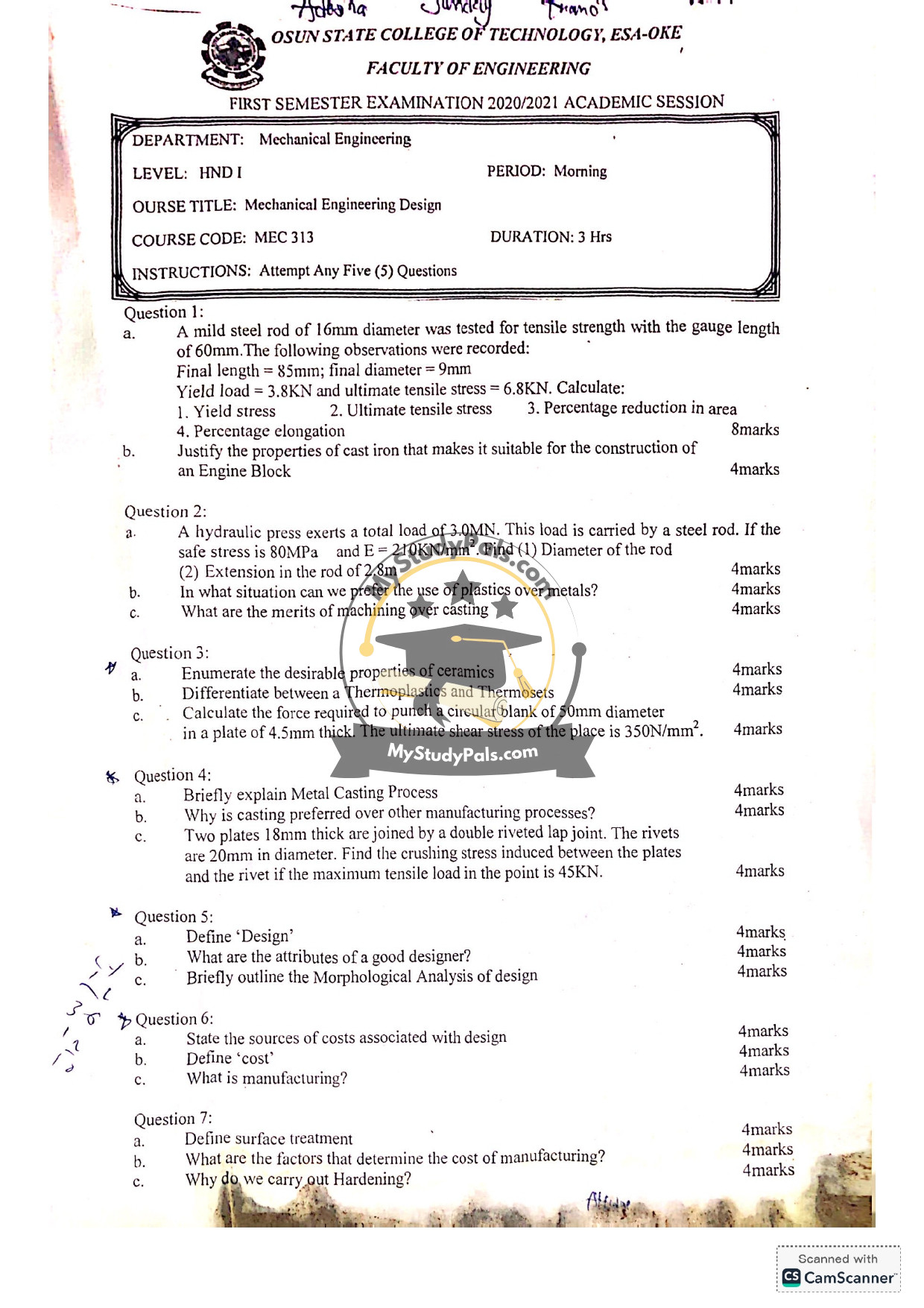ANWSER
Question 1:
a.
1. Yield Stress:
– Original cross-sectional area \( A = \frac{\pi}{4} \times (16)^2 = 201.06 \, \text{mm}^2 \).
– Yield load = 3.8 kN = 3800 N.
– Yield stress \( = \frac{3800}{201.06} \approx 18.9 \, \text{MPa} \).
2. Ultimate Tensile Stress:
– Ultimate load = 6.8 kN = 6800 N.
– Ultimate tensile stress \( = \frac{6800}{201.06} \approx 33.8 \, \text{MPa} \).
3. Percentage Reduction in Area:
– Final area \( = \frac{\pi}{4} \times (9)^2 = 63.62 \, \text{mm}^2 \).
– Reduction \( = \frac{201.06 – 63.62}{201.06} \times 100 \approx 68.3\% \).
4. Percentage Elongation:
– \( \frac{85 – 60}{60} \times 100 \approx 41.67\% \).
b. Cast Iron for Engine Blocks:
– High wear resistance, good thermal conductivity, excellent vibration damping, cost-effective, and suitable for complex casting shapes.
—
Question 2:
a.
1. Diameter of Rod:
– Safe stress \( = 80 \, \text{MPa} \).
– Area \( = \frac{3.0 \times 10^6 \, \text{N}}{80 \, \text{N/mm}^2} = 37,500 \, \text{mm}^2 \).
– Diameter \( = \sqrt{\frac{37,500 \times 4}{\pi}} \approx 218.6 \, \text{mm} \).
2. Extension in Rod:
– Strain \( = \frac{80}{210,000} \approx 0.000381 \).
– Extension \( = 0.000381 \times 2800 \, \text{mm} \approx 1.067 \, \text{mm} \).
b. Plastics over Metals:
– Lightweight, corrosion resistance, electrical insulation, and cost-effective for complex shapes.
c. Merits of Machining:
– Higher precision, better surface finish, and tighter tolerances compared to casting.
—
Question 3:
a. Ceramics Properties:
– High hardness, thermal stability, wear resistance, electrical insulation, and corrosion resistance.
b. Thermoplastics vs. Thermosets:
– Thermoplastics: Re-meltable. Thermosets: Irreversibly cured.
c. Punch Force:
– Shear area \( = \pi \times 50 \times 4.5 = 706.86 \, \text{mm}^2 \).
– Force \( = 706.86 \times 350 \approx 247.4 \, \text{kN} \).
—
Question 4:
a. Metal Casting Process:
– Molten metal poured into a mold, solidified, and removed to form a desired shape.
b. Casting Preference:
– Ideal for complex geometries, large parts, and cost-effective mass production.
c. Crushing Stress:
– Crushing area \( = 2 \times 20 \times 18 = 720 \, \text{mm}^2 \).
– Stress \( = \frac{45,000}{720} \approx 62.5 \, \text{MPa} \).
—
Question 5:
a. Design:
– Process of planning specifications for constructing an object/system.
b. Good Designer Attributes:
– Creativity, technical knowledge, problem-solving, and user-centric focus.
c. Morphological Analysis:
– Systematic decomposition of design parameters and combination of solutions.
—
Question 6:
a. Design Cost Sources:
– Materials, labor, prototyping, testing, and compliance.
b. Cost Definition:
– Total expenditure to produce a product, including resources and labor.
c. Manufacturing:
– Conversion of raw materials into finished goods via processes like machining or casting.
—
Question 7:
a. Surface Treatment:
– Modifying surfaces to enhance properties (e.g., coating, hardening).
b. Manufacturing Cost Factors:
– Material, labor, equipment, complexity, and production volume.
c. Hardening Purpose:
– To increase material hardness and strength through heat treatment.


